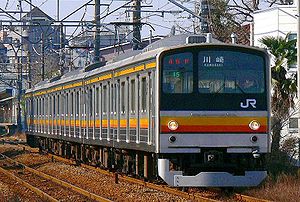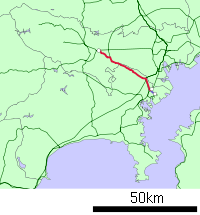- Nambu Line
-
Nambu Line
南武線
205-0 series EMU near Inadazutsumi bound for KawasakiOverview Type Heavy rail Locale Tokyo, Kanagawa prefectures Termini Kawasaki
TachikawaStations 26 (main line), 3 (branch line) Operation Opened 1927 Owner JR East Rolling stock 205 series, 209 series Technical Line length 45.0 km (28.0 mi) Track gauge 1,067 mm (3 ft 6 in) Electrification 1,500 V DC overhead catenary Route map The Nambu Line (南武線 Nanbu-sen) is a Japanese railway line which connects Tachikawa Station in Tachikawa, Tokyo and Kawasaki Station in Kawasaki, Kanagawa Prefecture. For most of its length, it parallels the Tama River, the natural border between Tokyo and Kanagawa prefectures. It is part of the East Japan Railway Company (JR East) network. The name refers to the southern (南 nan) part of the ancient province of Musashi (武蔵) (now Tokyo and northern Kanagawa prefectures), through which the Nambu Line runs.
Contents
Basic data
- Operators, distances:
- Total: 45.0 km (28.0 mi)
- Passenger: 39.6 km (24.6 mi)
- Freight: 39.4 km (24.5 mi)
- East Japan Railway Company (JR East) (Services and tracks)
- Kawasaki – Tachikawa: 35.5 km (22.1 mi)
- Shitte – Hama-Kawasaki: 4.1 km (2.5 mi)
- Shitte – Shin-Tsurumi Signal Station – Tsurumi: 5.4 km (3.4 mi) (no regular service)
- Japan Freight Railway Company (JR Freight) (Services only)
- Shitte – Tachikawa: 33.8 km (21.0 mi)
- Shitte – Hama-Kawasaki: 4.1 km (2.5 mi)
- Shitte – Shin-Tsurumi Signal Station: 1.5 km (0.9 mi)
- Total: 45.0 km (28.0 mi)
- Stations: 29
- Main line: 26
- Branch line: 3
- Double-tracking: Kawasaki – Tachikawa
- Railway signalling: Automatic Block System
Station list
Main line
Rapid service trains (two trains per hour between 10 a.m. and 4 p.m) do not stop at Shitte, Yakō, Hirama, Mukaigawara, Tsudayama, Kuji and Shukugawara. All other trains except for some seasonal services are local trains, stopping at all stations.
Nambu Branch Line
- All stations are located in Kanagawa Prefecture.
- Trains can pass each other only at Kawasaki-Shinmachi.
Station Japanese Distance (km) Transfers Location Between
StationsTotal Shitte 尻手 - 0.0 Nambu Line (main line), Nambu Line (freight branch) Saiwai-ku, Kawasaki Hatchōnawate 八丁畷 1.1 1.1 Keikyū Main Line
Tōkaidō Main Line freight branch (for Tsurumi)Kawasaki-ku, Kawasaki Kawasaki-Shinmachi 川崎新町 0.9 2.0 Hama-Kawasaki 浜川崎 2.1 4.1 Tsurumi Line, Tōkaidō Main Line freight branch (for Kawasaki Freight Terminal) Freight branch
The "Shitte crossover" (尻手短絡線 Shitte-tanraku-sen) connects Shitte Station and Shin-Tsurumi Yard on the Tōkaidō Main Line (Hinkaku Line) and the Musashino Line. Freight trains operating between Tokyo Freight Terminal and northern Japan operate on both branch lines.
Former branches
- Yakō – Kawasaki-Gashi: opened 1927, closed 1972
- Mukaigawara – Shin-Tsurumi Yard: opened 1929, closed 1973
History
The private Nambu Railway opened the line in five phases between 1927 and 1930 (freight branches are omitted)[1]:
- March 27, 1927: Kawasaki – Noborito
- November 1, 1927: Noborito – Ōmaru (near Minami-Tama)
- December 11, 1928: Ōmaru – Bubaigawara (then called Yashikibun)
- December 11, 1929: Bubaigawara – Tachikawa
- March 25, 1930: Shitte – Hama-Kawasaki
Passenger trains used electric multiple units from the beginning. Major freight was initially gravel from the Tama River. When the railway reached Tachikawa and made connection with the Ōme Electric Railway, limestone became one of main freight. The railway was controlled by Asano zaibatsu, which was enabled by the railway to transport limestone from its own quarry in Western Tokyo to its cement plant in Kawasaki without using the government railways.[2]
On April 1, 1944, the railway was forcibly purchased by the imperial government and became the Nambu Line of Japanese Government Railways. After the end of World War II, there were several movements to denationalize the line, but the line had been a part of the Japanese National Railways until its privatization in 1987.[2]
The postwar sprawl of the Tokyo urban area turned the most of the farmlands along the Nambu Line into residential areas and multiplied the passenger traffic on the line. On the other hand, freight traffic has been reduced after the opening of the Musashino Line in parallel to the Nambu Line in 1976 and the discontinuance of the limestone freight in 1998, except for the Nambu Branchline, which is a part of main freight route.[2]
Rapid services between Kawasaki and Noborito with stops at Musashi-Kosugi and Musashi-Mizonokuchi started on December 15, 1969, but were discontinued by the timetable revision on October 2, 1978.[3] After 33 years, rapid services between Kawasaki and Tachikawa with more stops started on April 9, 2011, postponed from originally scheduled March 12 due to the earthquake in Tōhoku on March 11.[4]
Rolling stock
Current
The current EMU fleet used on Nambu Line services is based at Nakahara Depot.
- 205-0 series 6-car EMUs (since March 1989)
- 205-1200 series 6-car EMUs (since 2004)
- Two 209 series 6-car EMUs (since April 1993)
- Two 205-1000 series 2-car EMUs (Nambu Branch Line services, since August 2002)
Previously used
- 72 series 4/6-car EMUs (from 1963 until 1978)
- 101 series 4/6-car EMUs (from 1969 until January 1991)
- 103 series 6-car EMUs (from 1982 until December 2004)
- 101 series 2-car EMUs (Nambu Branchline services, until November 2003)
References
- ^ Ishino, Tetsu et al. (eds.) (1998) (in Japanese). Teishajō Hensen Daijiten - Kokutetsu JR Hen. Tokyo: JTB Corporation. pp. 65-69, vol. II. ISBN 4533029809.
- ^ a b c Harada, Katsumasa (1999) (in Japanese). Nanbu-sen Ima Mukashi. Kawasaki: Tamagawa Shinbunsha. ISBN 4-924882-28-3.
- ^ "南武線に33年ぶりの「快速」" (in Japanese). Town News. October 1, 2010. http://www.townnews.co.jp/0206/2010/10/01/71075.html. Retrieved April 9, 2011.
- ^ "JR南武線快速ようやく運行スタート、旧国鉄時代以来33年ぶり". Kanagawa Shinbun. April 9, 2011. http://news.kanaloco.jp/localnews/article/1104090029/. Retrieved April 9, 2011.
External links
 Media related to Nambu Line at Wikimedia Commons
Media related to Nambu Line at Wikimedia Commons- Stations of the Nambu Line (JR East) (Japanese)
JR East lines Shinkansen 
Main Local Agatsuma · Akabane · Aterazawa · Ban'etsu East · Ban'etsu West · Echigo · Gonō · Hachikō · Hachinohe · Hakushin · Hanawa · Iiyama · Ishinomaki · Itō · Itsukaichi · Iwaizumi · Jōban · Jōetsu · Kamaishi · Karasuyama · Kashima · Kawagoe · Keiyō · Kesennuma · Kitakami · Koumi · Kururi · Mito · Musashino · Nambu · Narita · Negishi · Nikkō · Ōfunato · Oga · Ōito · Ōme · Ōminato · Rikuu East · Rikuu West · Ryōmō · Sagami · Senseki · Senzan · Shinonoi · Sotobō · Suigun · Tadami · Takasaki · Tazawako · Tōgane · Tsugaru · Tsurumi · Uchibō · Yahiko · Yamada · Yamanote · Yokohama · Yokosuka · YonesakaOthers Chūō Rapid · Chūō-Sōbu · Gala-Yuzawa · Keihin-Tōhoku · Saikyō · Shōnan-Shinjuku · Sōbu Rapid · (Tōhoku Jūkan - under construction)Past Categories:- Lines of East Japan Railway Company
- Rail transport in Tokyo
- Rail transport in Kanagawa Prefecture
- 1067 mm gauge railways in Japan
- Operators, distances:
Wikimedia Foundation. 2010.


